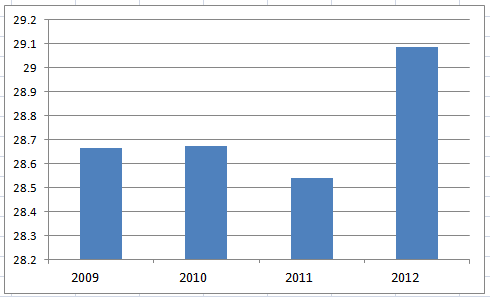Febuary 2013 Expedition - Chagos in Climate Week - Is warmer water killing coral
Since 2006, we‘ve had temperature loggers deployed at different sites and depths around the Chagos atolls. Recording temperatures at two-hourly intervals, they provide some interesting observations on coral cover and mortality, which at times, is worrisome. One of our jobs on this expedition is to recover as many of these as we can find, download the data and replace them for further monitoring.
During our time in Salomon atoll, we’ve found one of our loggers displaying some concerning data. Deployed at a 5m depth in the lagoon on a ‘bommie’, it has logged that the coolest temperatures last year, never reached below 28 degrees. In earlier years it commonly dipped to 27 or below.
Whilst average seawater temperatures have risen a little bit over the four years, the full picture is much more complicated. As with so many things, averages - especially annual averages - mean much less than the ranges of whatever we are measuring. In the case of corals, it is the periods of extreme temperatures that matter much more. Thus the ranges about that slightly raised average were ‘tighter’, without any cooler periods. Over this recorded period, warming has happened, and the figure shows the average.
We’ve also found another massive mortality of corals in all four places in the lagoon where we dived. Mortality has been especially high below around a 15m depth. Above that depth, cover by living and apparently thriving corals is nearly 100%. Then after a fairly sharp transition zone, the corals are almost all dead. The dead coral colonies are still in their positions of growth, and the corals here are (or were) large leafy forms. They are fragile and won’t last long like that before crumbling away.
The explanation of this we can’t be sure, but it does not look like disease. An earlier study here showed no or little disease, and coral diseases are usually not so depth-critical in their effects, (here the same species in shallower water are still thriving anyway). At the moment I suspect the cause is th
e average warmer water last year, or perhaps the lack of any cooler periods to give any respite. In the great wipeout that occurred in 1998, I estimated that the critical temperature was just under 30 degrees (though all species differ a bit of course), and in the last year there was a prolonged period of around this critical temperature but without cooler periods. We shall see. The consequences of hundreds of hectares of dead corals will be interesting, to say the least.
On seaward reef slopes of Salomon atoll, the reverse is true. We are also recording a series of transects where we count juvenile corals - that is colonies less than 15 mm diameter. There are record numbers of these at all depths and on all slopes. Most don’t survive of course.Things like parrot fish scrapes take out most of them, but the potential for thenext generation’s growth is there and the seaward reefs are thriving. Furthermore, they are thriving at all depths where we can dive to. More on that later…

Figure 1: Annual average temperatures of seawater at a data logger deployed for 4 years at 5m depth in Salomon atoll. Temperatures are degrees C.
Charles Sheppard

